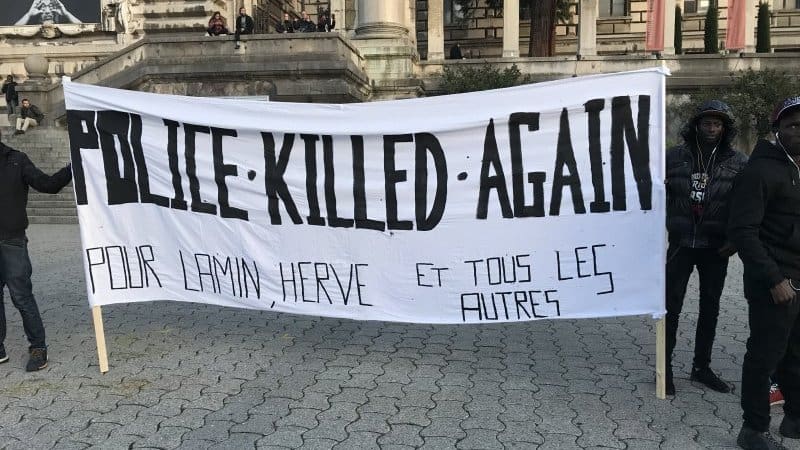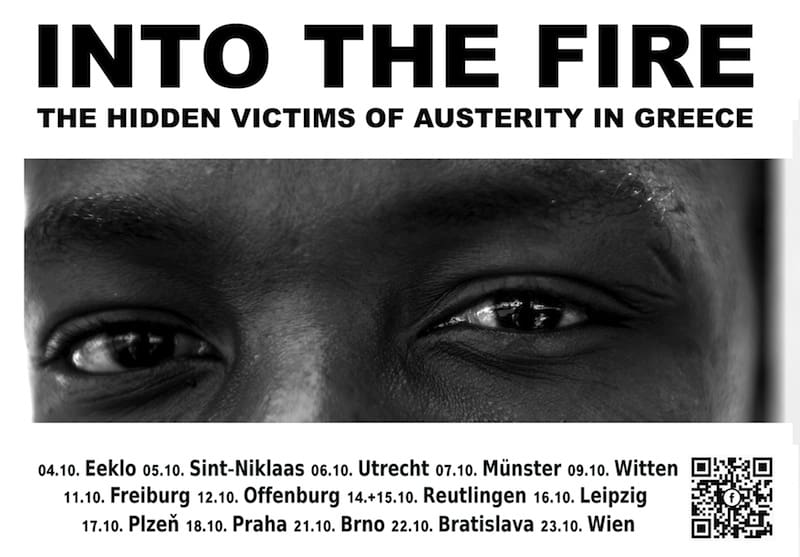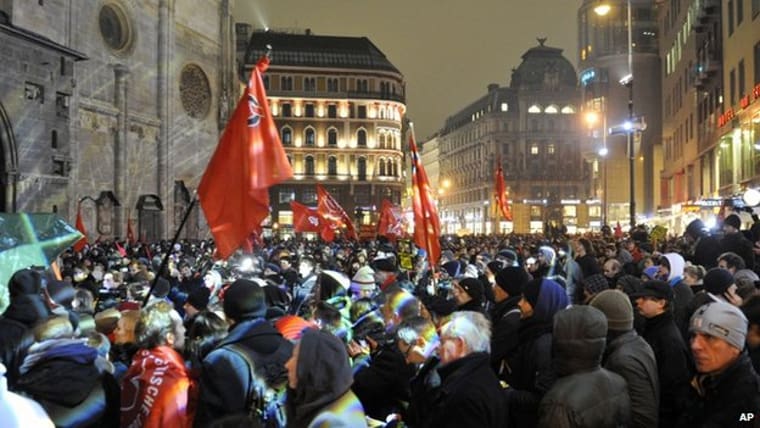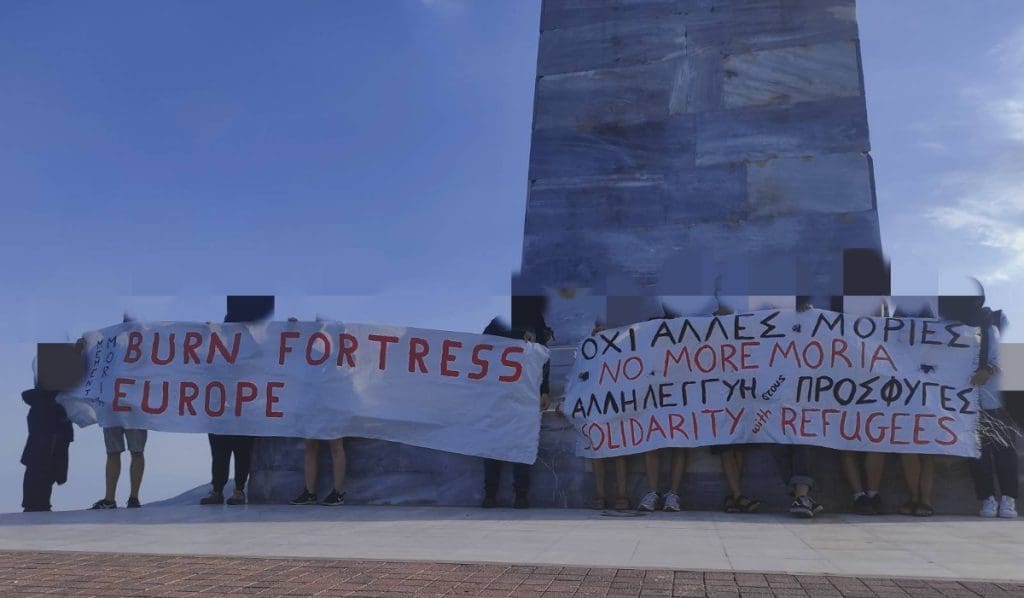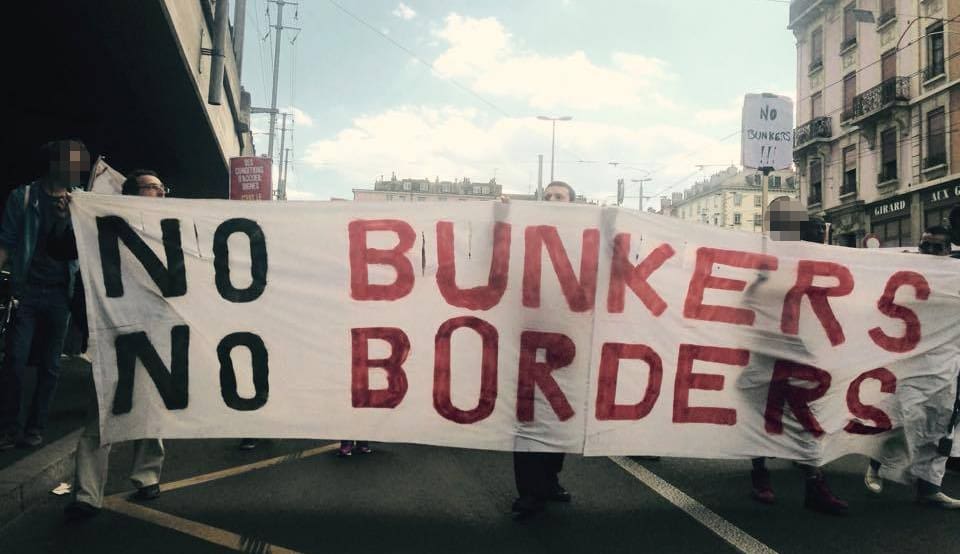“He died because he’s black!”
The Swiss police and border system kills three in five weeks
by Paul Kellner for ajour magazin (Switzerland)
23 November 2017 (original post n German)
Shot to death; found dead in a cell; fallen off a cliff – in the space of just five weeks, three refugees died in Switzerland during police operations. Headlines? Outrage? Hardly.
The series of deaths began in the picturesque Ticino border town of Brissago on Lago Maggiore. In the refugee shelter there, a fight broke out among residents on the night of 6 October 2017. When two police officers entered the shelter escorted by two asylum-seekers, a third asylum-seeker allegedly attacked these two escorts with a knife in each hand. “To guarantee the bodily integrity of all those present,” one of the Ticino cantonal police officers shot the alleged assailant. Despite the officers’ administering first aid, the 38-year-old Sri Lankan succumbed to his injuries on the spot. This is according to the police report.
What the police report as well as the widely-circulated dispatch on the Swiss wire service sda both left out: the 28-year-old police officer shot not just once, but three times; the officer apparently did not aim at the legs as protocol demands, but rather at the chest; and the distance between victim and shooter was only about two meters.
But who cares about these details? Certainly not the German-language press in Switzerland, which was satisfied with simply reprinting the minimalist sda wire. Critical inquiry? Journalistic research? Nah. The story as recounted by police seemed to add up well enough. An “asylum-seeker armed with knives” (Aargauer Zeitung) attacking police and others—in Switzerland this requires no further explanation. Every shot fired is legitimate, sang the Helvetian legacy media in unison. Blick was alone among them in adding one tiny tidbit more about the person killed, Subramaniam H.: “When Subramaniam drank, his temper would flare.”
Solidarity with police; hostility for the bereaved
Officialdom, as ever, sings from the same hymnal. Ticino justice chief Norman Gobbi, from the xenophobic party Lega dei Ticinesi, wrote in a Facebook status the very night of the incident: “I express my faith and confidence in the work of Ticino’s cantonal police as well as the police in general.” Not a word about the person killed. The next day, Gobbi appeared at the police press conference and gave the police commanders his full support—well before an investigation into the incident could ever have been completed.

The rightwing extremist made clear where his priorities are: “I stand with the officers,” said Gobbi solemnly, “but also with the relatives of the victim.” How humane! But the insincerity of Gobbi’s sympathy soon revealed itself. Four relatives of Subramaniam H. traveled from Sri Lanka to Switzerland for the funeral. His wife and both of his sons took the opportunity to apply for asylum themselves; Subrahamiam’s brother simply vanished underground. “This is unacceptable and makes me angry!” ranted Gobbi, who had gone out of his way beforehand to warn the Swiss ambassador to Sri Lanka of the “risk” of asylum claims.
Fellow Lega member and national parliamentarian Lorenzo Quadri, also in a Facebook status, spat: “Oh, great! Congratulations, federal bureaucrats! Thanks to your guilelessness, we now have three more illegals in our country. […] And of course their travel expenses were covered by the everyday taxpaying joe.”
It was not only Ticino’s rightwing extremists who attempted to capitalize on the bloody incident. The town of Brissago thought it would seize the moment by trying to rid itself of asylum-seekers once and for all. Town authorities lodged a complaint with the state assembly: sheltering asylum-seekers, for such a small town, so near an unguarded border, with not even a town cop much less regular security checks at the shelter, was simply untenable.
Deadly jailhouse in Lausanne
Just two weeks after shots rang out in Brissago, Lamin Fatty died in the clutches of the Vaud cantonal police. The 23-year-old Gambian had run afoul of the Ausländergesetz, Swiss immigration law, and had been arrested by border guards the day before in the Lausanne train station, from where he was taken to the Mont-sur-Lausanne police station and locked up. During the night of 23 October 2017, according to Vaud cantonal police, they found Fatty lifeless in his cell. There were no signs of “auto-aggressive acts,” i.e. suicide; cause of death was “unclear.”

As it happens, there was also a lack of clarity around Fatty’s arrest. The police had been looking for a person of interest, and thought Fatty fit the description. They later admitted, however, that it was a case of mistaken identity—the admission came too late for the dead man. While the French-language Swiss media contented themselves with describing the cause of death as “unknown,” the black community and social movements of Lausanne got the jump on them. One critique, spread widely on the internet, put it this way: “The newspapers love to write that ‘we don’t know how Lamin died.’ This is wrong. We know all too well: Lamin died because he was black and had uncertain legal status.”
Beyond that, people around Lamin have emphasized that he had suffered from severe epilepsy and that he had recently had an operation. The university hospital of Lausanne, where Lamin had been treated before his arrest, had found him fit and released him into the hands of the state.
Run off a cliff by police
The third case of police-involved death occurred on 9 November 2017 in the Graubünden mountain town of Valzeina, above Landquart. Police portrayed the incident this way: a 20-year-old Afghan was threatening fellow residents of his refugee shelter with a knife. When the police arrived at the scene, the Afghan threatened to take his own life. Medical backup was then requested. But “the man slipped out, and around 9:45 p.m. he fell roughly two hundred meters off a rock face into the Trittwald.” His corpse was retrieved the following morning.

This case also seems to interest nearly no one. Of course the state’s attorney has initiated an investigation as mandated. But besides that, an iron silence reigns. It doesn’t take much imagination to begin painting the picture: a desperate refugee is suffocating under prison-like conditions and the dismal loneliness of a remote mountain town; he becomes aggressive, police arrive; he makes a break for it and runs to the edge of a cliff and threatens to jump. That the mere presence of police could only have increased the pressure on an apparently suicidal illegalized person—leading to escalation—is indisputable. But the press writes of a “drama,” and a “tragic accident.” It’s worth an idle daydream: what would the media echo have looked like if it hadn’t been a refugee but a suicidal native Swiss person who “slipped out” during a police call?
Kill and Let Die: The collateral damage of the everyday
Self defense, unexplained cause of death, accident. Whether the official accounts reflect reality isn’t likely to be determined by the pro forma investigations underway. But it’s not much of a stretch to suggest murderous intent on the part of the police—experience alone has taught us that this is far from out of the question. Of course there is a difference between police willfully killing or letting people die and their victims simply dying by unlucky coincidence. But the real scandal requires no speculation: it is the completely normalized and democratically legitimized operation of the Swiss deportation machine that intentionally makes life a living hell for the most vulnerable. For years, officials have openly endorsed and stood by the most repulsive methods of immiseration and harassment. “We do it because otherwise they won’t leave,” Zurich functionary Mario Fehr (Social-democratic Party) recently explained, referring to his canton’s system of bounding orders and confinement to bunkers.
In the Bündner town of Valzeina where the Afghan refugee fell to his death, the shelters that rejected asylum-seekers are sent to vegetate in are not underground bunkers, but the principle is the same. Miles away from any significant settlement, in the most remote corner of a mountain valley, the so-called Office of Police and Civil Rights has banished refugees to an isolated village of 140 souls.

Protests: “Silence aids the killer, never the victim!”
But canton Graubünden didn’t take the mountain residents of Valzeina into account! Ten years ago, townspeople came together to form an antiracist organization, and since then have fought tirelessly against the authorities’ high-handedness and for a solidary community. On the website of Vereins Miteinander Valzeina, there is information as detailed as it is hair-raising about the inhumane conditions within the Bündner immigration system [check out their 2007 video, embedded below, as well (Ger/Eng)]. VMV was already raising alarms about the “emergency” regime in 2011: “Illness and aggression will be the logical endpoints.” Officialdom is certainly also aware of this; the measures they implement are supposed to work that way.
The Afghan who fell off a cliff is not the Bündner government’s first body. In 2013, the Palestinian Feraz Farees was found beaten to death in a living container at the Waldau “Minimalzentrum” near Landquart—a collection of structures described as a “very nice facility” (Heinz Brand, national parliamentarian for the Swiss People’s Party [SVP]) for “mostly criminals” (Janom Steiner, ex-SVP, now member of the cantonal governing council for the Conservative

Democratic Party [BDP]). A year before that, the abhorrent container settlement had burned down completely—sympathetic Bündners regarded it as likely at the time that the fire was set by the settlement’s residents.
“Stop killing us!”
The only public protest in response to this string of deaths has arisen in Lausanne, although that has made the mobilizations there all the more impressive. Several hundred demonstrators, mostly people of color, heeded the call to “rise up for our dead brothers” issued by the precarious migrants’ squatters collective Jean DuToit. The crowd chanted “Black Lives Matter!” and “Arrêtez de nous tuer!”
A week later, the street was taken once again, this time by over a thousand people, to memorialize Hervé Mandundu, who was killed in Bex a year ago. Like in Brissago, police had also downed Hervé with three shots. For Hervé’s mother, this clearly suggests something beyond self-defense: “Three bullets? They did that to kill him.” She will not tire of repeating this.
In Ticino, on the other hand, there were no such mobilizations. Nonetheless, a few “Enemies of All Borders” analyzed the situation in the southern canton insightfully: “There is a force, one that gets strengthened and legitimized on a day-to-day basis by the way events are portrayed in the media, that is creating an ever more dangerously fertile ground for the rise of actual fascism—just fascism served up in a democratic sauce.” Regarding the resounding, thoroughgoing silence and ignorance, they write, “Silence has always only aided the killers, never the victims.”

This observation, by the way, is being borne out prominently in Germany, in the case of Oury Jalloh. In 2005, Jalloh burned to death in a jail cell in Dessau. According to the official version of events, he had succeeded in setting both himself and his flame-resistant mattress on fire with a cigarette lighter—while handcuffed. His friends as well as antiracist groups doubted this version from the beginning, and demanded a full investigation and accountability for those responsible. Only now—after thirteen years of campaigning, researching, and investigating from below—has the state position as well as the media narrative shifted to suspicion of murder. While legal proceedings are unlikely, the police’s attempt at a cover-up was ultimately unsuccessful.
With that: Never Trust a Cop!
Translated by Antidote
All images via ajour magazin

